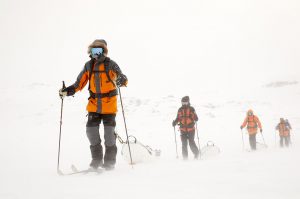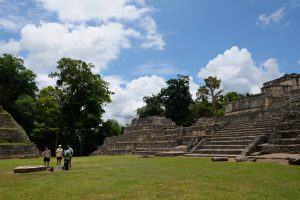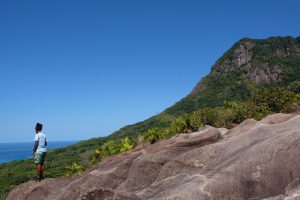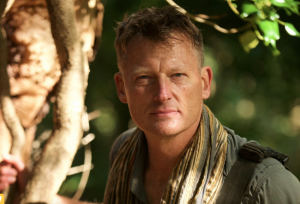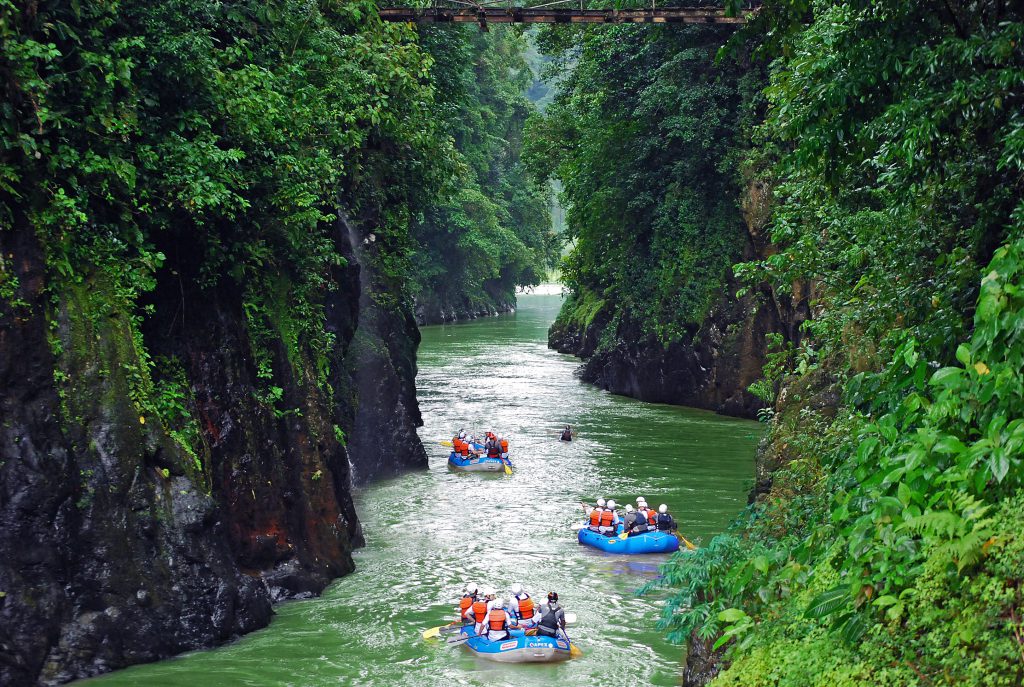
Journey across southern Costa Rica and discover one of the most biodiverse countries in the world. Home to extraordinary wildlife species and some groundbreaking eco-lodges, it is a place ripe for adventure, from whitewater rafting and jungle treks to boat trips across tropical waters that glow in the dark.
Read the article online on nationalgeographic.com
Precariously perched at the nose of the bucking raft, I stab my paddle into the foam of a rapid, as the soothing noises of the rainforest — just moments ago layered birdsong and sibilant river — are replaced by the frenzied roar of water meeting rocks. Behind me, an urgent shout: “Forw–ard! Forward!” I try to row but the inflatable boat pitches and I find myself aloft, sliding from my seat, feet slipping from their holds, my oar meeting nothing but air. What a terrible mistake this has been, I think, as the raft slams back into the water and I find I’m still on board: I am sure humans are not meant to contend with these forces, let alone sail them for sport. “Get down! Get down!” — another command from the guide at the stern. Our team of four rowers clumsily grab for the safety ropes, raise our oars, slither onto the cramped floor space and brace, all this in a second as the raft collides with a giant boulder and ricochets powerfully into calm, flat waters.
What grade had that rapid been? A fearsome IV? A death-defying V? “You survived your first grade II,” Marcello Delgado, calls out encouragingly. “Great work! Now, forward!” Despite a patter of well-tested jokes about this being his first day on the job, Cello (as we’re asked to call him) is a whitewater fanatic, passionate about spending his days instructing on the Pacuare River, the main artery of Costa Rica’s rafting scene. So too is the ‘safety kayaker’, Alex Cordero, a nimble scout who shoots down the rapids ahead of our raft to plot the route and scan for obstacles. It’s Alex, up in front, who models how to respect — not fear — the currents: he dances with the Pacuare, dipping, diving, twisting, turning and even floating backwards down her churning courses.
When Cello moors the raft in a protected bend for us to swim beneath a waterfall, the song of the rainforest fills my ears again — an indistinct, chattering chorus of insects and birds that seems amplified by the sheer sides of the gorge. As we tread water in the sun-dappled plunge pool, fish flitting at our ankles, he draws my eye to an iridescent blue morpho butterfly, as large as the span of his hand, flapping lazily between trees. “They like the water,” he says, simply, “like me.” Before we head on, Alex playfully conducts Eskimo rolls in the shallows — capsizing his kayak while still inside and righting it with core strength. This strange river, this impenetrable forest, on my first full day in Costa Rica — they’re transforming minute by minute into an enchanting playground. And that’s before we reach our destination.
I’m rafting to one of the country’s most notable eco-lodges, a water-turbine-powered retreat no roads can reach in the Caribbean-facing Limón province. Arriving soaked to the skin and sweating from exertion sets the tone for my days at Pacuare Lodge. Despite the elegance of its open-sided dining pavilion and 20 villas (all polished wood, sweeping terraces and fluttering drapes), this is a place to run wild. Somewhere to grow tanned as you hike in rubber boots through muddy nature trails; to float in an infinity pool during a rainstorm; to work up an appetite as you rappel down waterfalls and whizz along zip lines; and to enjoy the crackle of a bonfire as you dine on the river shore.
This is the first stop on a nearly fortnight-long bespoke itinerary put together by operator Audley Travel that takes me to four of southern Costa Rica’s most scenic and biodiverse enclaves, dodging the crowds by using rafts, quad bikes, ferries and even my own wheels to go further, deeper and more off-the-beaten track. The aim is to stay in eco-lodges that truly live up to the name by employing locals and leaving a light footprint. At Pacuare Lodge, I feel I’ve already hit the jackpot right out of the gate.
Before I pack up and raft out, I take a hike with softly spoken lodge guide Giovanni Taylor Damien into the hotel’s 930-acre forested reserve. We climb higher and higher, leaving the rush of the Pacuare behind us. Up here, where the treetops are draped with the occasional sloth and rainbow toucans loudly announce their flight paths, Giovanni teaches me to unstitch the soundscape, to pick out the euphonias, flycatchers and woodcreepers from the motmots, tanagers and manakins. He plays the birdsongs on a phone app so that the creatures sing back to him in response and shows me pictures of their bright markings up close on his screen after each sighting. “Until recently, guides used to carry around a heavy birding book — there are 900 species in Costa Rica. And in this humidity; you can’t imagine the state of the books after the rainy season!” he says, pocketing his device.
Some hours later, the rich, red mud of the river basin gives way to the cooler air and sandier earth of the higher ground. We break the dense treeline and the vista opens to reveal the misty foothills of the Talamanca Range, part of the Sierra Nevada, continually revised by tectonic forces, stretching as far as the eye can see. Giovanni’s brought me into the Nairi Awari Indigenous Reserve, home to some of the Cabécar people, the largest of Costa Rica’s eight indigenous groups, which together make up 2.4% of the country’s population. At the first homestead — a collection of traditional round wooden houses topped with conical palm-leaf roofs — we meet Ananias Jiménez Jiménez who works at the lodge. “Jishtu mashkina,” he says, wishing us a good morning in the Cabécar tongue.
This isn’t his home — it belongs to Vivian Däküey Bä, a silent, raven-haired teenager who greets us curiously and whose mother also works at the lodge — but Ananias is here to interpret a little of the culture for me on his neighbours’ behalf. This is one of the very few places in the country that offers this exchange; many Cabécar communities live apart from the rest of society, on designated lands.
These days, the big cultural event is a meeting of five Cabécar hill communities over a raucous football match. “Once the invite is sent out, Cabécares will walk for days to congregate. It’s a way for the girls to meet the boys, and for us to drink dÿ,” he laughs, referencing the local sugar-cane hooch.
For those who live in proximity to the Cabécar, there’s lots to be learnt and gained, and not just in the crops, woven bags and totemic, balsa-wood animal carvings they sell locally. “We’ve picked up natural remedies that we can even offer guests,” Giovanni says, “like maracas flowers to repel mosquitos or ortiga leaves for muscle aches. For centuries, they’ve lived close to nature in this forest, taking only what they need. We think about that a lot.”
Birds of a feather
It is a good thing I don’t know the name of the darkening mountain pass I am currently driving through and on which thick fog is descending. Had I been paying closer attention to the map, I might have seen the words ‘Cerro de la Muerte’ (‘Hill of Death’) written across a zigzag of hairpin bends. But for now, I’m simply navigating the playful twists of the Pan-American Highway — with ears popping, now more than 3,500m above sea level — peering at passing road signs to find the turn off to a hard-to-reach but high-reward destination: the bird-watching haven of San Gerardo de Dota.
The half-day journey has gifted me an understanding of the sheer variety of terrain across Costa Rica. I’d picked up my hire car in the city of Siquirres, where the rapids released us elated paddlers back into civilisation. And while the Pacuare barrelled onwards towards the Caribbean coast, I’d turned inland, driving with the windows down through the farmlands and puffing volcanoes of the Central Valley, up and up, to the crisp highlands of southern Costa Rica. When I finally do reach the cosy Trogón Lodge, nestled in a dramatic mountain fold on the edge of Los Quetzales National Park, the night is very dark, cold and clear — the Milky Way smeared across a sparkling tapestry of stars.
It’s this stark, almost-Alpine beauty that draws committed travellers to this pocket of the country — that and its thriving population of one particular bird species. Resplendent quetzals are near-endangered and have a mythical beauty; many MesoAmerican civilisations considered them sacred. The Maya and Aztecs plucked their 3ft tail feathers to decorate royal headdresses. At dawn, I join a group of fellow pilgrims — all sensibly wrapped up in puffer jackets of varying colours, all clasping telephoto lenses — outside the hotel with manager and experienced birder Greivin Gónzález. “Every time I see one, it’s like my first time,” he says, leading us through the town to an orchard of wild avocado trees the birds sometimes visit for early-morning grazing.
Greivin is well practised in building anticipation. During the sighting-free hours that follow, he fills the cold morning air with facts, speaking in a low, gentle voice so as not to scare away a prospectively peckish quetzal. I learn the brightly hued males grow their long plumes ahead of mating season between February and May, while the females are more modest in appearance. And although sightings in other Central American nations are rare due to habitat degradation, in Costa Rica, where 28% of the land is protected, and where the locals around San Gerardo de Dota carefully cultivate food sources, the population is growing.
“Can you hear that? Here comes a female!” Greivin announces suddenly. A rotund bird swoops onto a shady branch and sits, twitching her head, in a perfect tableau framed by hanging lichen and sprouting bromeliads. She’s magnificent: a deep turquoise rippling across her wings and neck and cherry-red on her chest, with black-and-white scallop patterns on her tail feathers. “See how she becomes green and gold in the sunlight?” Greivin says, commentating with the rapid-fire urgency of a sports commentator. “And look, a male!” Our group of birders frantically reposition spotting-scope tripods to get a closer look. With his colours even brighter than the female and his thin, twin, forking tail feathers almost at full length, the male cuts a long, serpentine shape in the air, bobbing as if coasting on waves. It’s a divine visitation, brief and dazzling; the birds dine and dash back into the forests, leaving me with memories so bright they could have been hallucinations.
When it rains
The journey to reach my next lodge in the country’s most remote and biodiverse outpost, the turtle fin-shaped Osa Peninsula in the far south, takes the best part of a day and a relay of transportation. Back on the twisting Pan-American, I drive in glorious sunshine through soaring vistas, where wispy clouds snag on dragon-spine peaks. Where the road kisses the Pacific at the backpacker resort of Dominical, I switch onto the Costanera Highway, traversing the Golfo Dulce Forest Reserve to eventually wind up in the low-slung town of Puerto Jiménez. Meeting my transfer beside the airstrip (the flanks of which double as the local cemetery), a hardier vehicle then bounces me along rutted dirt tracks and through swollen streams to the hamlet of Carate. It’s here, on the edge of a spectacular dark-sand beach that seemingly stretches for miles, I’m met by a cart horse and a quad bike.
“Normally we’d just load your bags on the horse and ask you to hike the two-miles to the camp, but the tide’s coming in fast — and a storm,” says La Leona Eco Lodge manager Agustín Briones, revving up the quad bike. “You better hop on.” Under mutinous, lead-grey skies, we zoom along the deserted beach, weaving around scattered coconuts and fording shallow streams seeping from the dense tree line. To my left, the ocean sucks and hisses, waves spilling lace-work foam under our wheels. On the right, I glimpse movements in the treetops; the forest seems alive.
The lodge, I discover, merges seamlessly with these surroundings. Simple, ocean-front safari tents with alfresco showers gaze out on the water; at night, the property’s rustic trails and open-sided canteen is illuminated by little more than stars and candlelight. “Sometimes you can search for days for an animal and then it just shows up at the lodge,” Agustín says, as he serves me a classic Tico (Costa Rican) supper of fried snapper, plantain, and beans and rice that night. Rain hammers torrentially on the iron roof of the canteen, competing with the riled-up Pacific to drown out our conversation. “We even had a puma come right through the lodge when it was quiet here, out of season. We had to escort guests around.”Undeterred, I strike out in the morning with local nature guide Alvaro Montoya to Corcovado National Park. At 164 sq miles, it’s the largest in Costa Rica; it was created in 1975 to disperse the logging and gold rush industries that had taken root here. A trailhead lies just a short walk from the lodge. Almost as soon as we enter the forest, the sightings begin. There’s a grazing troop of squirrel monkeys in the canopy, an agouti rodent rooting in the undergrowth and a self-assured anteater strutting up ahead.
A pair of scarlet macaws beat the air above the trees. Alvaro has anecdotes and facts at his fingertips, interpreting the ecosystem and the motivations of different species. “I’m not a professional, I didn’t go to university, but I grew up here and know what I’ve seen.”
He’s keen to puncture my wide-eyed wonderment at Osa’s natural bounty with a deeper understanding of what it takes to survive in the wild. Nature, red in tooth and claw. There are the multicoloured toucans we see, straight out of storybook illustrations — “they eat other birds’ eggs”; cute white-faced capuchin monkeys drying their fur in the morning sunshine — “very sharp teeth; I’ve seen them kill birds!”; and a puma, fresh from the hunt, shown to me in a video Alvaro had shot on his phone earlier in the year — “hear how his teeth crack the howler monkey’s skull?” The earth we walk on is littered with crunchy confetti, too: the colourful, dismembered skeletons of Halloween crabs, a favourite snack of the larger birds.
But, even understanding this grizzly reality, it’s hard not to be swept up in the magic of the place. And, as the days pass, I find my place in the natural rhythm of things. I wake up at dawn to plant my footsteps on the blank canvas of the tide-washed beach. I learn to notice the nesting sites of sea turtles, and start to recognise the squawks of the red-lored parrot from the soft chirrups of the fiery-billed araçari bird. At dusk, I light candles and watch the sky and sea darken before a storm.
Let there be light
A few days, a Cessna flight and a ferry crossing later, I’m bobbing in a kayak on the placid, glassy waters of the Gulf of Nicoya, the nose of my craft turning like a compass, pointing towards different points on the horizon as I paddle. Rugged islands and rock stacks appear as fresh and untouched as if tectonic forces had only recently thrust them into the cloudless sky. “I’ve seen humpbacks there, just where you’re kayaking; orcas, too,” says Christian Rosáles, head of activities at Isla Chiquita, a predominantly solar-powered glamping hotel on the forested islet of Jesusita, just behind us. Christian’s at home on the water. He whistles at the kingfishers we pass, calls out to the pelicans like old friends and regales me with stories of mangrove replanting and saving giant turtles from fishing nets.
While the northwest coastline of Costa Rica generally offers some of the country’s most developed tourism infrastructure due to its platinum beaches and drier climate, days here at the tip of the Nicoya Peninsula are rustic, governed by the tides and the arc of the sun, with the only soundtrack the guttural whooping of resident howler monkeys. Activities revolve around the water. When not cooling off in my tent’s plunge pool high up on the island, I’m choosing my next outing down at Christian’s ‘office’ by the beach, a wooden gazebo draped with all the trappings of sailing adventures — life jackets, oars, snorkels and the equipment we’ll ultimately need for our next tour: fishing tackle.
As Christian explains when we cut the boat’s motor, a short ride from the hotel’s jetty, this is a lesson in artisanal fishing — catching our supper with a hand-held line, bait and a bit of skill, the way all the locals here do. Frigate birds circle above us in the tangerine dusk, anxious for scraps. I grit my teeth and spear a wriggling ghost shrimp onto my hook, then drop it to the seabed off the side of the boat and wait. The line is draped over my fingers, the aim being to feel the almost imperceptible nibble of a fish and tug the hook sharply upwards to snare it. But while Christian pulls in groupers and gently tosses back puffer fish and catfish, time and again my bait is stolen without me noticing. Wind in, re-bait, try again. Finally, a catch — a flapping red snapper that I haul aboard and grasp with firm hands. Dinner, after all. But we aren’t going straight home. Instead we joyride into the pitch black, weaving around neighbouring islands. The air is warm and silky; it’s hard to know where my skin ends and the night begins. Christian’s looking for a dark cove, somewhere shaded from the starlight and waning moon. “Trail your hand in the water,” he advises once we’ve slowed down. There’s an explosion of light where my fingers meet the ocean; I pull my arm out and it continues to glitter for a few moments — a gauntlet of bioluminescence.
As our eyes adjust, we’re able to track the sparkling movements of fish and rays in the shallows; I hadn’t known the underwater world could be so complex, so active, nor that it could light up from within with sapphire pixie dust. Christian explains these are dinoflagellates, a rare marine plankton reliably found in Nicoya’s tropical bays. He fills a jam jar so I can gaze at the glowing specks up close, then pours it into the boat, our sandalled feet now bedazzled with bluish embers. I want to bottle this childlike feeling of seeing the world anew, of joyfully puzzling at my place in the vast web of creation — a feeling I’ve come to treasure over the past fortnight. I look over at Christian. My guide is laughing, splashing his hands in the water. It seems the magic isn’t lost on him either.
How to do it
A 13-day tailor-made trip to Costa Rica with Audley Travel costs from £10,800 per person (based on two sharing), including stays at all the accommodation above plus San José.
The price includes international flights, transfers, car hire, accommodation and excursions.
Published in the June 2023 issue of National Geographic Traveller (UK).





